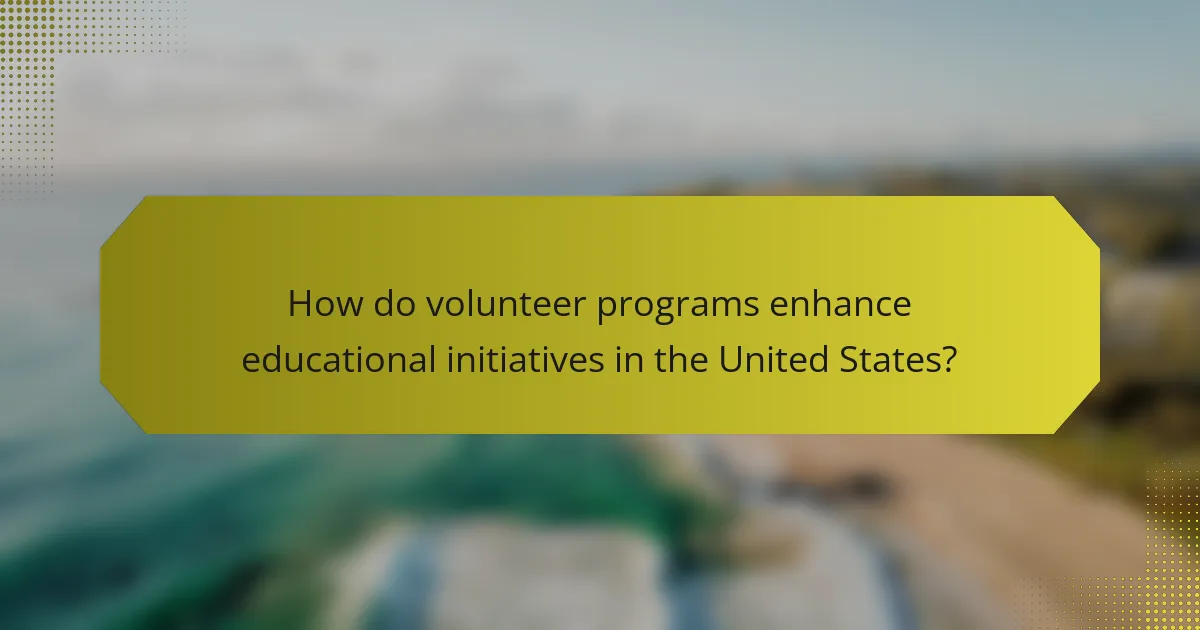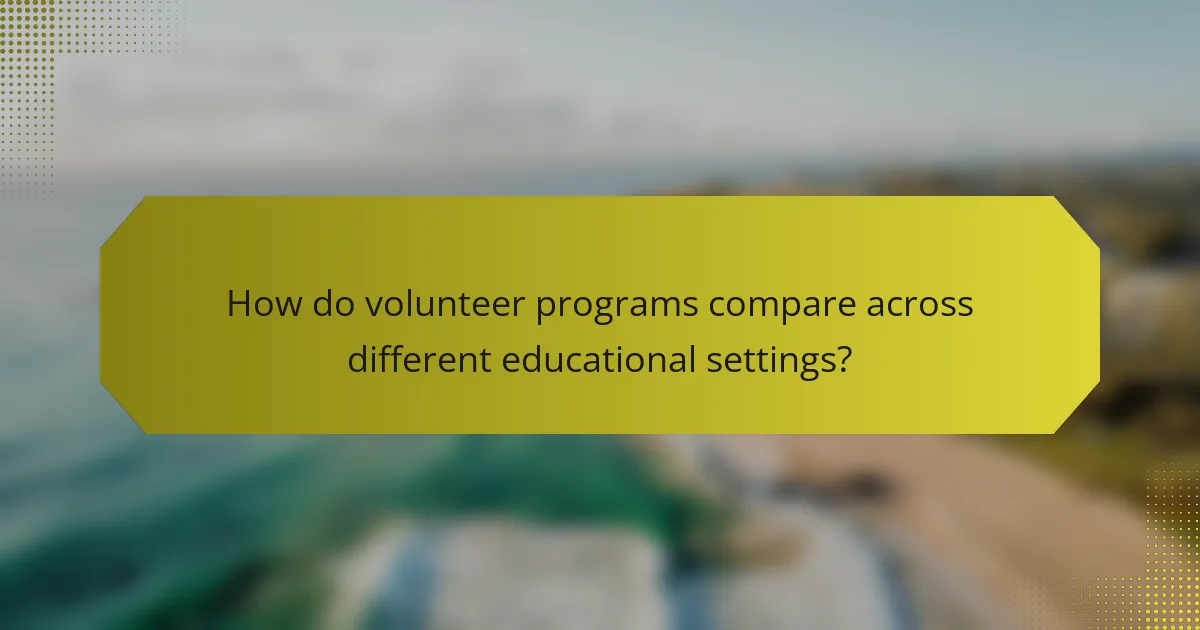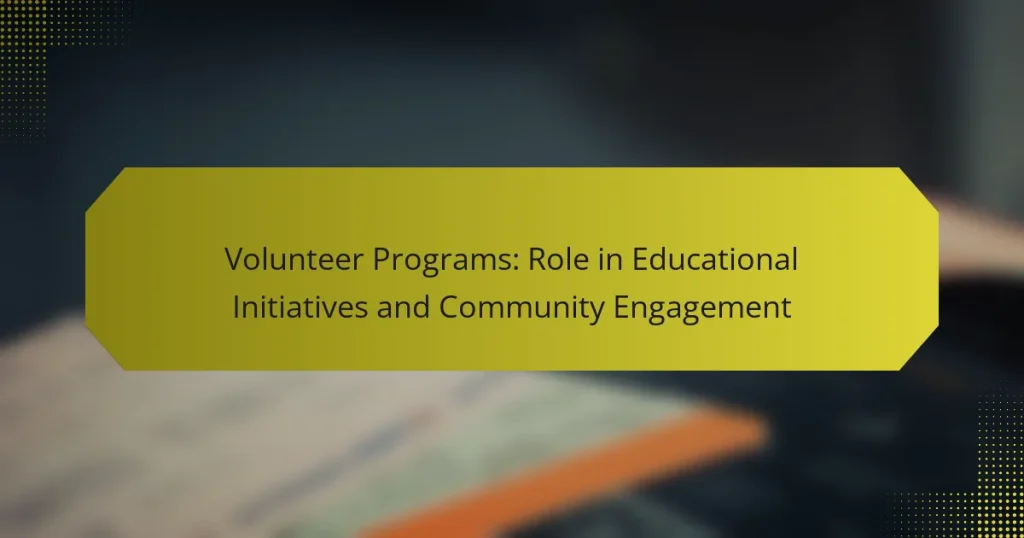Volunteer programs play a crucial role in enhancing educational initiatives by offering students practical learning experiences that connect their studies to real-world applications. Additionally, these programs foster community engagement, strengthening social ties and promoting a sense of responsibility among participants. By aligning volunteer efforts with community needs, organizations can create impactful programs that benefit both individuals and the broader community.

How do volunteer programs enhance educational initiatives in the United States?
Volunteer programs significantly enhance educational initiatives in the United States by providing practical learning experiences and fostering community involvement. These programs connect students with real-world applications of their studies, while also promoting a sense of responsibility and engagement within their communities.
Skill development through hands-on experience
Volunteer programs offer students the chance to develop essential skills through hands-on experience. By participating in activities such as tutoring, mentoring, or community service, students can apply theoretical knowledge in practical settings, enhancing their understanding and retention of the material.
For instance, a student volunteering at a local nonprofit may learn project management skills while organizing events, or improve their communication abilities by working with diverse groups. These experiences can be invaluable when entering the job market, as employers often seek candidates with practical skills and teamwork experience.
Increased student engagement and retention
Engagement in volunteer programs can lead to higher student retention rates in educational settings. When students actively participate in their communities, they often feel a greater connection to their education, which can motivate them to stay in school and pursue their studies with enthusiasm.
Programs that integrate community service with academic curricula, such as service-learning projects, have shown to boost student motivation and academic performance. Schools can encourage participation by offering incentives, such as recognition or academic credits, to further promote involvement in volunteer initiatives.

What are the benefits of community engagement through volunteer programs?
Community engagement through volunteer programs fosters collaboration and strengthens the social fabric of neighborhoods. These initiatives not only enhance personal connections among residents but also contribute to the overall well-being of the community.
Strengthened community ties and relationships
Volunteer programs create opportunities for individuals to interact and collaborate on common goals, which builds trust and camaraderie. By working together on projects, residents can develop friendships and a sense of belonging, which are essential for a cohesive community.
For example, organizing local clean-up events or community gardens allows participants to bond over shared experiences. These interactions often lead to long-lasting relationships that extend beyond the volunteer activities.
Improved local resources and support systems
Engaging in volunteer programs can significantly enhance local resources by pooling skills and talents from diverse community members. This collective effort can lead to the establishment of support systems that address specific needs, such as food banks, tutoring programs, or mental health services.
Communities that actively participate in volunteer initiatives often see an increase in available resources, as volunteers can identify gaps and work together to fill them. For instance, a neighborhood might create a resource-sharing network to help families access essential services more efficiently.

How can organizations implement effective volunteer programs?
Organizations can implement effective volunteer programs by establishing a structured approach that aligns with their mission and community needs. This involves setting clear goals, recruiting the right volunteers, and providing adequate training to ensure a successful engagement.
Define clear goals and objectives
Defining clear goals and objectives is crucial for guiding a volunteer program’s direction and measuring its success. Organizations should identify specific outcomes they wish to achieve, such as increasing community awareness, enhancing educational initiatives, or providing direct services.
For example, a local nonprofit might set a goal to improve literacy rates among children by 20% over two years through volunteer-led tutoring sessions. This clarity helps in aligning volunteer efforts with the organization’s mission.
Recruit and train volunteers effectively
Effective recruitment and training of volunteers are essential for the success of any program. Organizations should develop targeted outreach strategies to attract individuals whose skills and interests align with the program’s goals, utilizing social media, community events, and local partnerships.
Once volunteers are recruited, comprehensive training is necessary to equip them with the knowledge and skills required for their roles. This can include orientation sessions, ongoing workshops, and mentorship opportunities to foster confidence and competence.

What criteria should be considered when selecting volunteer programs?
When selecting volunteer programs, it’s essential to evaluate their alignment with community needs, potential for measurable impact, and overall sustainability. These criteria ensure that the programs are effective and beneficial for both volunteers and the communities they serve.
Alignment with community needs
Choosing a volunteer program that aligns with the specific needs of the community is crucial for its success. Conducting a needs assessment can help identify gaps in services or support that volunteers can effectively address. Engaging with local organizations or community leaders can provide insights into pressing issues and priorities.
For example, if a community struggles with literacy, a program focused on tutoring children or adults in reading and writing would be highly relevant. Conversely, a program that does not address local concerns may lead to wasted resources and volunteer frustration.
Potential for measurable impact
Evaluating the potential for measurable impact involves looking at how a volunteer program can produce tangible results. Programs should have clear objectives and metrics to assess their effectiveness, such as the number of individuals served or improvements in community well-being. This helps in understanding the program’s success and areas for improvement.
Consider programs that track their outcomes through surveys or data collection methods. For instance, a health initiative might measure changes in community health indicators before and after the program’s implementation. This data not only demonstrates impact but also helps attract future funding and support.

How do volunteer programs compare across different educational settings?
Volunteer programs vary significantly across educational settings, impacting their effectiveness and engagement levels. Public schools often rely on community-based volunteers, while private institutions may have more structured programs with specific goals.
Public schools vs. private institutions
Public schools typically engage volunteers to support diverse student needs, often focusing on tutoring, mentoring, and extracurricular activities. These programs are usually funded by local government budgets and community donations, which can lead to variability in resources and support.
In contrast, private institutions often have more formalized volunteer programs, sometimes requiring parental involvement as part of tuition agreements. This can create a more consistent volunteer experience, but may also limit participation to families with more financial means.
Urban vs. rural program effectiveness
Urban volunteer programs often benefit from a larger pool of potential volunteers and diverse community resources, which can enhance program effectiveness. However, they may face challenges such as higher competition for volunteer time and greater logistical issues due to city infrastructure.
Rural programs, while potentially limited in volunteer numbers, can foster strong community ties and personalized support. The effectiveness of these programs often hinges on local engagement and the ability to mobilize community members around specific educational initiatives.

What are some successful examples of volunteer programs in education?
Successful volunteer programs in education often focus on enhancing student learning and engagement while fostering community involvement. Programs like Teach For America and City Year exemplify how volunteers can make a significant impact in schools and communities across the United States.
Teach For America
Teach For America (TFA) recruits recent college graduates to teach in underserved schools for two years. Participants receive training and support while working to close the educational achievement gap. This program emphasizes the importance of educational equity and encourages volunteers to become lifelong advocates for change.
Volunteers typically teach in high-need areas, often in urban or rural settings. They may face challenges such as limited resources and diverse student needs, but they gain valuable experience in classroom management and curriculum development. TFA alumni often continue their careers in education, policy, or community service.
City Year
City Year is a national service program that places young adults in schools as tutors and mentors for one academic year. Volunteers, known as “AmeriCorps members,” work alongside teachers to support students’ academic and social-emotional development. The program aims to improve student attendance, behavior, and course performance.
Members engage in activities like one-on-one tutoring, leading after-school programs, and organizing community service projects. City Year focuses on building relationships with students and fostering a positive school culture. Participants gain leadership skills and often pursue careers in education or social services after their service year.

How do volunteer programs influence student career paths?
Volunteer programs significantly shape student career paths by providing practical experience and insights into various fields. Through hands-on involvement, students can explore their interests, develop skills, and make informed decisions about their future careers.
Exposure to various professions
Participating in volunteer programs allows students to gain firsthand experience in different professions, which can clarify their career aspirations. For instance, a student volunteering at a local hospital may discover a passion for healthcare, while another working with a non-profit organization might find an interest in social work.
This exposure helps students understand the day-to-day realities of various jobs, including the skills required and the challenges faced. Such insights can be invaluable when choosing a major or seeking employment after graduation.
Networking opportunities for students
Volunteer programs often connect students with professionals in their fields of interest, creating valuable networking opportunities. Engaging with mentors and industry leaders can lead to internships, job offers, or recommendations that enhance a student’s career prospects.
To maximize these networking benefits, students should actively participate in discussions, attend events, and follow up with contacts made during their volunteer experiences. Building a professional network early can provide a competitive edge in the job market.

What emerging trends are shaping volunteer programs in education?
Emerging trends in volunteer programs for education focus on leveraging technology and addressing social justice issues. These trends enhance the effectiveness of volunteer initiatives while promoting inclusivity and equity within educational settings.
Integration of technology in volunteer training
The integration of technology in volunteer training allows for more flexible and accessible learning experiences. Online platforms and mobile applications can facilitate training sessions, making it easier for volunteers to participate regardless of their location.
For instance, virtual reality (VR) can simulate classroom environments, helping volunteers practice their skills in realistic scenarios. This tech-driven approach not only saves time but also engages volunteers in innovative ways, improving retention of training material.
Focus on social justice and equity initiatives
Volunteer programs are increasingly prioritizing social justice and equity initiatives to address systemic inequalities in education. This focus ensures that volunteers are equipped to support marginalized communities effectively.
Programs may include training on cultural competency, anti-bias education, and community engagement strategies. By aligning volunteer efforts with social justice goals, organizations can create a more inclusive educational landscape that benefits all students.


